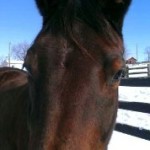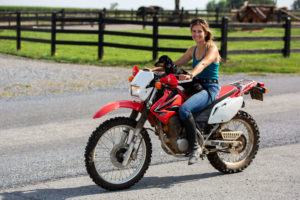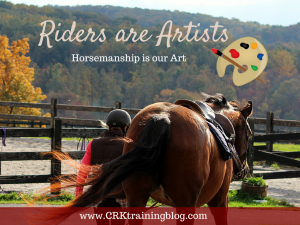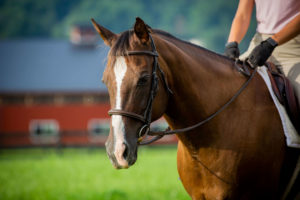Did you ever consider that the swirl on a horse’s body could give you instant clues to his personality? Or they could help predict where a horse many be stiff, resistant, or have trouble bending?
I was aware that some people paid attention to swirls and their meanings, but I had honestly never gave them a second thought. Probably because the few times I heard about swirls were from a particular horse dealer who was persuading me to buy a specific horse and pointed out he had the “swirls of a champion.” I never bothered to learn more, assuming swirls were just an old wives tail used by dealers to sell horses.
In recent months, I have had several people bring up the subject of swirls and their meaning, and this time my interest was piqued enough to persuade me to do some research. I decided to find out what the theory was behind swirls and then examine some of the horses I am currently working with to do my own little subjective study.
The Theory
First off, a swirl is a patch of hair growing in a different direction, also called whorls, cowlicks, and trichoglyphs, and are found on the horses forehead, on the flanks, and numerous other places over the body. The method of swirls to make assumptions about a horse date back to the Bedouins of Arabia. European gypsies also relied on the study of swirls as did many old time horseman. Linda Tellington Jones popularized the swirl method with her research in the 60s, 70s, and 80s.
A horse’s swirls are formed before birth and never change. This is why swirls were also used as a way to identify horses on old registry papers and other places where identifications was needed. The forehead swirls are considered to be the most indicative of temperament because the forehead hair is the first to grow on the embryonic fetus, and it is thought that the development of swirls is linked directly to development of the brain. Also, the nervous system and the skin come from the same embryonic layer, further pointing towards a connection between swirls and the brain. The theory states that as energy flows through the body it is redirected or disrupted by unusual swirls, causing the reactive or explosive nature of horses with the undesirable swirl pattern.
Here are the most common swirl patterns and their supposed meanings:
Ideal swirl pattern – one swirl on the forehead between the eyes, and 2 identical swirls on either side of the bridlepath, not extending past the length of the ear folded back. Flank swirls are even on both sides.
Forehead Swirls
- One swirl between the eyes indicates an easy going, uncomplicated horse
- Swirls higher on the forehead indicate greater intelligence and a more reactive nature
- Long swirls, especially those that extend below the eyes indicate a friendly and agreeable nature
- Multiple swirls on the forehead can indicate multiple personalities, high and tight side by side swirls can mean a horse that is super focused and talented, but challenging and difficult in the wrong hands
- Two swirls on top of each other can mean extreme personality swings and unpredictability
- Multiple swirls that form a Z pattern can signal a horse that is dangerous and violent
Swirls in other random places on the horse’s body can signal stiffness or unevenness in stride if there is a swirl on only one side of the body.
If the flank swirls are uneven, the horse will bend easiest in the direction of the swirl that is furthest back or the direction of the longest swirl. Likewise, if a horse’s forehead swirl grows clockwise, that horse will tend to be right sided, where if it grows counterclockwise the horse will be more left sided. This was actually confirmed in a study by Ireland’s University of Limerick.
Another study was performed by animal scientist Temple Grandin of Colorado State University along with her assistant, Mark Deesing. They studied cattle in the auction ring. Cattle with high swirls fought more than those with lower swirls. Additional research has been done in other species that solidifies connections between temperament and hair. For example, humans with developmental disabilities are more likely to have abnormal hair whorls, just as connections have been made between the direction of a person’s hair swirl and whether they are right handed or left handed. Studies have been performed in rats to show that breeding for rats with black hair also produced rats that were tamer and easier to handle. Some believe that a horse’s coat color plays a role in personality as well, with bays being preferred for a steady temperament, while blacks and greys are thought to be more difficult, and chestnuts more high strung.
I found all these ideas very interesting, and as it usually goes, the more I read on the subject, the more interested I became. So I went out excitedly to take pictures of the faces and swirls of my current horses.
These are pictures of my three horses, Molly, Nell, and Ace from left to right. All three have a typical single swirl. Nell’s swirl (Nell is the grey horse) is highest, and I wouldn’t call her reactive, but she is very intelligent and has always learned very quickly. The rest of the horses on my farm (there are 22 right now) all have a single swirl pattern, which makes sense because it is the most common.
These are the four double swirl horses on the farm. The first horse pictured, a mare named CC, has two swirls on top of each other, and while this mare can vary day to day, as sometimes she is quiet, other days she is more of a handful, I wouldn’t call them extreme mood swings. The middle two really don’t fit the stereotype, but the horse on the right does have a reputation for being difficult and somewhat unpredictable. He also seems to learn slower than average.
Now this is a very unique swirl pattern, and this creature is known by everyone in the barn to be stubborn, willful, and to ram people when they least expect it.
I hope you enjoyed my swirl research. I’m not convinced yet, but I will start looking at hair patterns more closely! What kind of swirl does your horse have? Do they fit into the theory of “swirlology?”
Callie






















14 Responses
I have watched everything you have on YouTube and find your information interesting and well organized. I am a “young” 80 years old and have started riding lessons and Apprentice Training in the past year. I loved horses all my life and pleasantly found ways to spend my remaining years in the company of horses. Thank you so much for you calm energy and youthful exuberance.
Hi Pat, I applaud you for taking up lessons and training! Great job and I am sure your life experience and wisdom will serve you well with the horses!
Very late to comment on this thread but you have given me inspiration as I thought I was very unusual in that I didn’t start riding until I was 62yrs old. I’ve always loved horses but also was a bit fearful of them and never had the time or opportunity to take lessons. Now I’ve been taking lessions for over a year and I love it! I find I’m not ‘too old’ at all and one day hope to have my own horse.
I am definitely going to look at the swirls on my horse when I get home! (I’ve been house and dog sitting for my parents last week and I miss my horse very much! But I’m enjoying the internet because I’ve stumbled upon your site and have learned a lot already!)
Reading about the differences in horses’ swirls made me remember something that I would like to share with you and other readers. A fee weeks ago I was reading a book about some women who ride at a draft barn together and they mentioned that different colored horses have different smells. Yeah, I know it was only a fiction story, but a lot of horsey fictions have a lot of truths in them, so of course I went out to smell our horses! And sure enough, they smelled different! Actually, my Summer is a palomino paint and his colored spots smelled different from his white spots! I thought I was imagining it, but my fiancee said he could tell the difference also.
So I just thought I’d share this with you, in case you want to run around your barn smelling your horses
Interesting! I may have to test that out and smell my horses, haha!
My understanding is facial swirls can help determine a horses temperament. And, knowing his temperament you can plan a training program that will work best for him. My problem is trying to figure out what swirl my horse has. It is very confusing. One Web site: Swirlogy , the study of hair swirl or whorles in horse by Charlotte Cannon has lots of pictures and information if you are interested in knowing more.
Horseanality by Linda Parelli also interest me. I am all for any information that helps me better understand my horse.
I agree with Joy. Don’t judge a book by it’s cover!
I meant Jewel – I agree with Jewel!
Hoping this doesn’t scar horses with the “undesirable” whorls for their lives. Despite these “theories” every horse is unique. I think to mark them like this is wrong. It’s just my opinion. I have a horse with one swirl, directly between his eyes. He’s nothing like the description for this type. I have another with a swirl directly between her eyes and she’s completely different than the other. I just think that labeling horses with “violent”, “reactive”, and “unpredictable” is dangerous for the animal. Even labeling them with “easy going” and “uncomplicated” could land someone in the hospital if they take this seriously. Each and every horse is unique and not at all the same. They need to be treated with respect and an open mind with preparedness, not like a zodiac sign.
i agree, although interesting, i dont know that it is terrible scientific.
My horse has swirls on his chest, wonder what that means. it could mean that certain bloodlines where born with those certain swirls. LOL
Do you have advice on training your horse to respect personal space? Also, my 4 year led mare has a very bad habit of trying to steal other horses grass as we walk through the stable, pulling me along with her. Help!
I’ve been interested in the study of whorls since I adopted a colt a couple years ago with double swirls, side by side. My vet pointed it out and said, “He’s going to be smarter than his own good.” I don’t care to label horses like this, but I think the information can be valuable with training. Always best to be aware.
I’m a bit late to this blog entry-but wanted to add that if you get the LT Jones book-the swirl is just part of the entire facial assessment, which includes ears (set, width, shape, length, upright and relaxed positions), eyes of coarse, head shape from front and side, muzzle, chin, nostrils.
Much of it makes sense as of course a larger eye-set properly and without a roman nose -has a better chance of good vision. Chins, cheeks and nostrils all have something to do with their ability to breath and chew amongst other things. It is a fascinating study, and the more complex featured heads usually do house a more complex creature-which is not a judgment on their train- ability or temperament.
My own mare-lucky me!-does have ALL the features of a complex thinker according to this book, in addition to an offset swirl. Figuring out how to honor her intelligence and occasional over the top reactivity, as well as her focused work ethic and growing social manners has been a terrific journey. I felt the information was just another window to look through and not a format for putting a label on her. She is calm, forward and rhythmic with steady nerves under the oddest circumstances sometimes-but also truly benefits from long and pleasant daily trail rides.
Along with her body type, conformation, breed history and her personality, swirls and head shape studies add dimension to my observances of her. She’s not like any horse I’ve ever been around-having had over the top, curious and friendly high energy-but low fearful middle of the herd type geldings. I’ve gotten much better at reading her very minute messages that she might be in the over reactive zone -or easily going there-which is a good thing-as it is “tongue in cheek” spectacular chaos if I fail to pay attention. My geldings have all had big, round, centered sworls with a variety of typish warm blooded heads. She has a lovely-straight nosed wedge shaped head, with the offset sworl higher up. All a lot of fun to ponder!